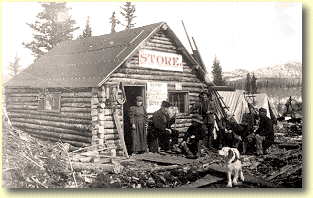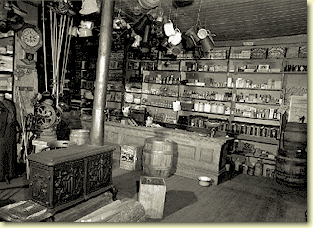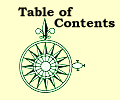![]()
The Cariboo Gold Rush brought miners from all over in search of gold. Their search would have failed had they not had the proper equipment such as blasting powder for tunneling and gold pans for sifting through the river banks, separating gold from dirt. Miners soon invented easier tools and machines to aid their search. Sluice, flumes, and cradles were more productive in the search for golden wealth. Sluicing washed out dirt and separated gold by using pressure from running water. Where water was not readily available, miners used flumes which were long toughs that used gravity to bring water to mining sites. A cradle allowed a miner to sift through large amounts of dirt and was more productive than panning. By rocking a cradle back and forth, rocks were separated from finer gold dust that fell through small holes.

BC ARCHIVES D-08105 "General Store "
The mining communities which sprang up throughout the Cariboo region brought work to those outside the mining industry. Shop owners were needed to order and provide basic living necessities like food, clothing and housing material. Shop owners stocked a number of items ranging from flour, tea and sugar to stationery, fish hooks and liquor. Food prices varied depending on how much of a particular product was available. Most stores relied on products coming form outside the region which meant the prices could rise if a shipment was delayed. Tea from China, coming through the coastal ports of Vancouver and Victoria were often delayed due to land and sea transport delays. Tobacco was irregularly shipped from the Hudson's Bay Company in the east. Oats, flour, sugar, salt and coffee were transported by wagon roads to the mining communities, bad roads or weather conditions meant supplies would be late causing the prices to rise.

BC ARCHIVES "List of Goods "
A general store in a mining communtiy not only sold food. Building materials were also available to the miners set on establishing a home from which to mine for riches. Most stores stocked a number of carpentry and blacksmith tools including: locks and bolts; saws, shovels and hoes; axes and hatches; cast iron car wheels; nails and rivets; as well as iron, steel and rope. In a sense, the general store in a mining community was a life line to the miners who relied on a supply of food, clothing and tools for mining and shelter.

BC ARCHIVES I-27062 "General Store "
Miner's Equipment
|
Free Miner's Certificates
Miner's Pick
Round-nosed Shovel
Clean-up Pan
Matches and Compass
Packsack
Small Plastic Bottle
Food
|
Gold Pan
Brass Gold Tweezers
Pry Bar or Breaking Bar
Axe
Magnet
Area Map
Claim Tags
Miscellaneous
|



|
Last updated November 30, 1998. Produced by Industrial Art Internet Group Ltd. © 1998-1999 |
